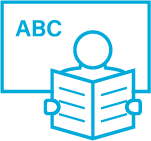The Role of Reading Disability Risk and Environmental Protective Factors in Students’ Reading Fluency in Grade 4
This study explored the role of reading disability risk in kindergarten and environmental factors in Grades 1–3 on reading fluency in Grade 4. Evidence was found that environmental protective factors predicted students’ improved reading fluency and reading disability risk predicted fewer protective environmental factors, which partially mediated the effect of reading disability risk on reading fluency.
Authors: Noona Kiuru, Marja-Kristiina Lerkkanen, Pekka Niemi, Elisa Poskiparta, Timo Ahonen, Anna-Maija Poikkeus, & Jari-Erik Nurmi
Source: Kiuru, N., Lerkkanen, M.-K., Niemi, P., Poskiparta, E., Ahonen, T., Poikkeus, A.-M., & Nurmi, J.-E. (2013). The role of reading disability risk and environmental protective factors in students reading fluency in Grade 4. Reading Research Quarterly, 48(4) pp. 349–368 | doi:10.1002/rrq.53
This study explored the role of reading disability risk in kindergarten and environmental factors in Grades 1–3 on reading fluency in Grade 4. Evidence was found that environmental protective factors predicted students’ improved reading fluency and reading disability risk predicted fewer protective environmental factors, which partially mediated the effect of reading disability risk on reading fluency.
- Fluent reading is a necessary skill for academic success as well as gathering information from printed and electronic sources.
- The risk of reading disability may result in poor reading skills.
- Not all children at risk end up with poor literacy skills. Protective factors, such as positive relationships with adults and peers, may affect development of fluent reading despite the reading disability risk.
Defining fluent reading
Fluent reading is the ability to read with accuracy, speed, and proper expression and comprehension. It refers to the whole reading process from word decoding to word meaning and the construction of phrase- and passage-level meaning.
Defining reading disability
Reading disability is a difficulty in word decoding or slow, dysfluent, and inaccurate reading.
The risk of reading disability is thought to be 17%–20% of children, and is more common among boys, children of parents with low education, and children with low general ability.
Learning to read in Finnish is relatively easy, because Finnish has highly regular orthography and simple syllabic structure. However, reading disability is still present in Finland.
Defining peer acceptance
Peer acceptance is defined as experiences of being liked or accepted by the members of one’s peer group, companionship, and having a sense of connection to the larger peer group.
Defining good teacher-student relationships
Good teacher-student relationships are characterised by high degrees of warmth, support, and sensitivity, and provide a safe context for the development of academic competences.
Defining good home-school collaboration
This is a genuine partnership, including mutual respect, trust, and two-way communication, between parent and teacher with shared values and expectations about how to support the child.
The study
Protective environmental factors such as peer acceptance, good teacher-student relationships, and good home-school collaboration may promote the development of good reading fluency among children with a risk for reading disability.
Research questions:
- To what extent do environmental protective factors predict students’ reading fluency in Grade 4?
- To what extent does the risk of reading disability measured in kindergarten predict protective factors in students’ interpersonal environment during Grades 1–3?
- To what extent does the risk of reading disability measured in kindergarten predict students’ reading fluency in Grade 4?
- To what extent is the effect of reading disability risk on subsequent reading fluency mediated via protective factors from students’ interpersonal environment?
Participants were 538 students and their parents and teachers from 3 medium-sized towns and one municipality in Finland.
Findings
- Children with a risk of reading disability in kindergarten had lower reading fluency in Grade 4 compared to children who did not have reading disability risk in kindergarten.
- Children with a risk of reading disability were less accepted in their peer group, and their teacher showed less positive affect toward them, the quality of the partnership between their parents and teachers was lower, and they had fewer environmental protective factors.
- Peer acceptance, teachers’ positive affect for the student, and higher cumulative environmental support were related to better reading fluency in Grade 4.
- The effect of reading disability risk in kindergarten on subsequent reading fluency was partially mediated through teachers’ positive affect for the student during Grades 1–3.
- The effect of reading disability risk in kindergarten on subsequent reading fluency was partially mediated through cumulative environmental support during Grades 1–3.
- The effects of environmental protective factors on subsequent reading fluency did not significantly differ between the students with or without reading disability risk.
Implications
- We can predict children’s reading fluency in Grade 4 already in kindergarten by testing their reading disability risk (although the association is moderate). Therefore, other factors are considered important.
- The risk of reading disability in kindergarten predicts poorer peer acceptance, less sensitive teacher attitude, and reduced cooperation between teacher and parents.
- Less sensitive teacher attitude and cumulative environmental factors partly explain the association between reading disability risk in kindergarten and reading fluency in Grade 4; however, reading disability risk in kindergarten is also independently associated with reading fluency in Grade 4.
- It is important that students receive support in their learning from the beginning of school, that the teacher is sensitive toward the student, and that students are accepted by their peers.



